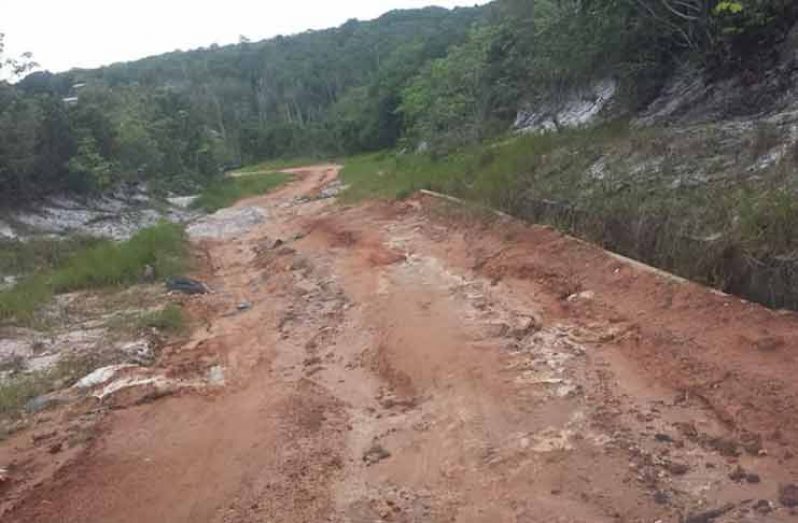RESIDENTS of the farming community of Moblissa, located on the Linden/ Soesdyke Highway, have always looked to the soil for a living as well as poultry and dairy operations.
In the 1900s, Moblissa was earmarked as having the largest dairy operation in the Caribbean and this led to the development of the community. Persons seeking employment at the then LIDCO Dairy Company eventually settled in Moblissa and became residents. The operation provided employment for 30 families and the economic situation was deemed favourable.
With the downsizing of LIDCO in 1990 after diversification and Government selling its majority share to one director, things took a turn for the worse and the families that lived there faced the brunt of the effect. Now, one person owns the over 5000 acres of land that LIDCO once operated on.
Explaining the current situation of the small community was its Community Development Council’s Chairman, Auther Reynolds. Reynolds said that LIDCO’s fall significantly contributed to the fall of Moblissa and while the population at that time expanded in the hundreds, residents who had already settled there, found it difficult to just move; and to this day, things are far from bright.

The farming, poultry and dairy work is still being done by residents, but mostly on a subsistence basis; only enough to provide for one’s family. Reynolds related that persons also engage in charcoal mining and logging to supplement their agricultural income. Some residents also rear sheep, ducks and pigs.
These, however, are not seeing favourable returns to get the community moving from remaining economically stagnated for all those years. Currently, a few outsiders have dairy operations in the community and a few residents are employed on these farms.
STANDSTILL
“Dairying is at a standstill in Moblissa, people don’t really milk animals anymore, they just raise the animals to slaughter for Christmas or Qurbani; somebody would slaughter an animal and get a $100,000 or more, and that helps to keep them going,” Reynolds related. He himself rears a few heads of cattle and because it cannot adequately maintain his family, he had to seek employment by other means.
As a result of the stagnated economy in Moblissa, there is a huge generation gap, with the youths leaving as soon as they have finished their secondary education.
Reynolds related that the youths would have shunned the situation in Moblissa and decided to look for betterment. “When children grow up and see their parents in that situation, they don’t wanna be around that,” he said.
A few youths who decided to stay have benefited from the Hinterland Education Youths Programme (HEYS) which will conclude in July. Most of them will use their entrepreneurial grants to commence poultry rearing. While Reynolds hailed the initiative, he said it is not enough to turn the community around, to the place it was before. He believes that the Ministry of Agriculture needs to intervene expeditiously.
INTERVENTION NEEDED
“It needs some intervention, so we are calling on the Ministry of Agriculture and other ministries to have a first-hand look at agriculture to earmark a few folks to resuscitate it and monitor them,” he reasoned.
Another challenge facing residents is that the lands on which they farm and live, are unregulated and while notable strides have been made for the residents to be furnished with their leases, after many decades, they still remain squatters.
Reynolds described this as being harsh, since the residents cannot access loans from financial lending institutions.
If agriculture is resuscitated in Moblissa, Reynolds is optimistic that the good old days will return and the anxieties of life will not encroach on the simple, peaceful life the residents are accustomed to. As the gateway to the Intermediate savannahs, several hinterland communities such as Tacama, St Cuthbert’s Mission and St Ignatius can all be accessed from Moblissa. “It’s a lovely community, it’s a peaceful place that we living in. I’ve been living there since 1989; that is why I make it my home, it’s peaceful for me.”
NO ATTENTION
Moblissa borders both Region’s 10 and Four but administratively belongs in Region Four. One of the other major challenges residents are facing is that no attention from the Region Four administration is placed on the community, despite several promises being made.
While the residents turn to Region 10 RDC for assistance since it is closer, the little help that is received is not substantial, since monies in Region 10’s budget cannot be used in Moblissa. Region 10 Chairman Renis Morian has sought collaboration with the officials of Region Four several times to tend to the needs of the community and while these officials did visit, nothing more was done, according to the residents.
The major problem presently is the condition of the lone access road in the community. It is virtually impassable because of erosion and is a major threat to life and limb.
Reynolds transports students from the community to Linden and revealed that because of the state of the road, the bus almost overturned with the students last week.
“The hill is eroded very badly. Last week, I nearly turned over with the bus because it is eroded so much that I had to mobilise some people to put some sand bags so we can get out. With the rains, it has become more and more deplorable. As it is right now, to get in and get out is a challenge,” he said.
Adding to the destruction of the road is the Andy Gangadin Mining trucks that transport loam from the community. Though Minister within the Ministry of Natural Resources, Simona Broomes met the representatives of the company as well as residents during an outreach earlier in the year, Reynolds said that the situation has not been resolved and the company continues to abuse the community of its resources.
FROM POTHOLES TO CRATERS
“They haven’t come to sit down with us; they had an agreement to meet with, they never got back to us. Several phone calls, messages and they never responded. The road no longer has pot holes, it has craters; so when it rains, people have to hold up their pants and women would hold up their shoes in the hand and have to walk out to the highway,” Reynolds said.
A creek passes through the lone access road, and in 2011, two tubes were bought to construct drains to alleviate the erosion issue. It was never installed. Region Four RDC representatives visited the community and were in receipt with all information needed to have the job done, while creating employment for residents but, to date, the situation has worsened.
“They made a commitment along with the Region 10 Chairman to help fix the road and the creek and, to date, they haven’t done anything.”
Region 10 provided the community with a mist blower machine and RDC Region Four also promised to provide the chemical to spray the grass, but that has not been done either.
“I am calling for greater collaboration with Region Four,” Reynolds said as residents pleaded for someone in authority to help in the revival of their community.




.jpg)











